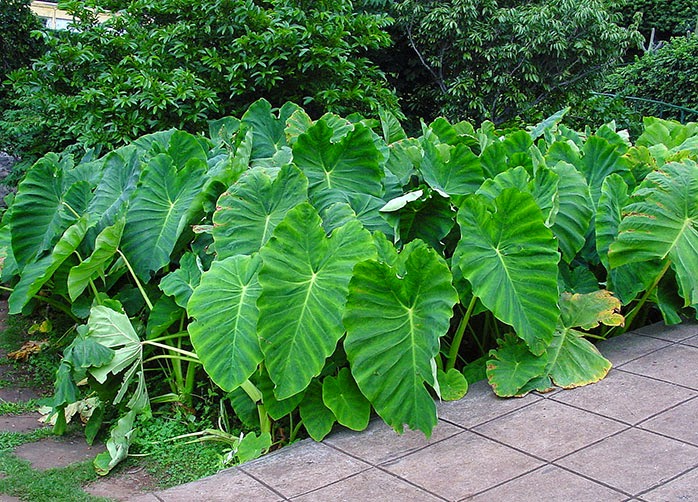By Nikos Lygeros *:
Kolokasi is an emblematic product of Cyprus and especially of the Sotira region, which should already have a Protected Designation of Origin.
Of course, experts also know the buttons. But let's deal with Kolokasi which is the largest part of the production.
Its scientific name is Colocasia esculenta and it has been known since Roman times.
Cyprus is an ideal region for its development. Kolokasi is traditionally an organic crop, even if this element has not been highlighted by the producers.
Its leaves have the property of lotus, ie it is superhydrophobic and is due to its surface and its nanometric structure.
It has the characteristics of a potato and grows in the ground.
This practically means that zeolite can offer it great growth and durability, as it cleanses the earth of heavy metals, toxins and free radicals.
In the integration, the potato can be made analogous, but we can of course also take advantage of the period when we cover the base of the plant with earth.
As for spraying with fine powder, it can be done with watering.
Thus, Cyprus can easily obtain a product that is organic from the beginning but also zeolite, in order to qualitatively increase its organoleptic properties.
This way we will have a genuine Kolokasi, traditional protected from zeolite.
A quality product can be born in the Sotira area and give its mark for its recognizability.
* Who is Nikos Lygeros:
Nikos Lygeros was born in 1968 in Volos, but at a young age he moved with his family to France. He is one of the 50 smartest people in the world and although he has a "heavy" biography, he fights daily with modesty and altruism for his only interest, as he admits, the man ..
As a researcher he holds various world records in the fields of algebra, number theory and combinatorics. He is a strategic advisor and professor of geostrategy at the Police Academy, the School of National Security, the School of Military, the School of Aviation and the School of National Defense in Greece.
As a professor of mathematics, computer science, government, epistemology, linguistics, bioethics he teaches at the Universities of Lyon, Athens and Thrace and at the Polytechnic School of Xanthi. He is the Chairman of the Committee of Art Schools (Ministry of Education), a teacher of gifted children, an expert interpreter and translator in French courts, a scientific advisor to the Karatheodoris Association of Friends, which aims to promote the scientific form of the greatest mathematician of modern Greece, Constantine.
He was an international observer in the presidential elections in Nagorno Karabakh.
He has founded the organization "ThePiSociety", whose members have an IQ of 176 points and above, which according to statistics corresponds to one person in a million.
Distinguished for his communication with children, specializing in guidance, counseling and career guidance for students and parents, he has worked with many schools in France, Greece and Cyprus.
He is a writer, director, poet, painter.
Nikos Lygeros is the Greek who holds the highest IQ on the Stanford-Binet scale, with 189 points.
He has published more than 6.400 articles, poems, literary texts, on mathematics, intelligence, physics, philosophy, education, mythology, religion, history, archeology, cinema, painting, music, politics, sociology, strategy, management, economics. Examples include:
A. Mathematics:
1. Mathematical Challenges,
2. Math Mathematics,
3. Structure elements of hyper - structures
B. Essays
1. Leonardo da Vinci: The universal genius,
2. Mental Strategy,
3. European strategic plan,
4. Elements of contemporary strategy,
5. Humanities and Tempus,
6. Codex,
7. Mental Geostrategy,
8. Human dignity,
C. Poetry collections:
1. Source of rum,
2. Luminostalgia,
3. Invisible color,
4. The dragon souvenir,
5. The croix of the dragon.
D. Scenarios:
1. The shadows of the Tower,
2. At the crossroads of blue.
E. Comedies:
1. Autoreference,
2. Alter Ego,
3. One Piece.
F. Drama:
1. Les demiurges,
2. Les jackals,
3. The black spots,
4. The black lights,
5. World dialogues,
6. Ludwig,
7. Time strings,
8. Cinq movements for a silence,
9. L 'homme qui n'existait pas,
10. FormidabilesHomines,
11. The man without dreams,
G. Tragedies
1. Orestes and Electra,
2. Achilles and Penthesylia,
3. Odysseus and Calypso,
H. Oratorio
Prometheus and Athena,
Th. Opera
Centaur and Titan,
I. Novels
1. Le chevalier sans armure,
2. The thirty kisses of the sun,
Ia. Short stories:
1. Les Caméléons,
2. Living things,
3. Under the sole,
4. Humane Revolutions.
Ιβ. Poetry collections with art:
1. Le monde de Vincent, catalog of painting exhibitions
2. The Vincent World, bilingual edition
3. Under the weight of an ear of corn,
4. Pedagogy
Ιγ. Translations:
1. The mythology of the Vrettakos flowers,
2. The Miracle of Koumakis,
3. Erotokritos - Versified translation.
Id. Solo painting exhibitions
1. Cultural Center of the Municipality of Kalamata, February 2009
2. Hall of the History Center of the Municipality of Alexandroupolis, March 2009
3. Historical and Paleontological Museum of the Municipality of Ptolemaida, June 2009
4. Palais des Congrès de Perpignan, June 2009
5. De Chirico Hall of the Municipality of Volos, September 2009
6. Historical Museum of the Municipality of Kozani, October 2009
7. Gallery of the Municipality of Larissa, October 2009
8. Mairie du 6eme arrondissement de Lyon, October 2009
9. Fleming ArtGallery, Thessaloniki, November 2009
10. Municipal Gallery of Xanthi, February 2010
11. Engineering Building, Komotini, April 2010.
12. French accommodation, Rhodes, June 2010
13. Syros Art Gallery, Ermoupolis, October 2010
Iε. Group painting exhibitions
1. Lyon Resistance Museum. May 2009
Source: sotira.org.cy

